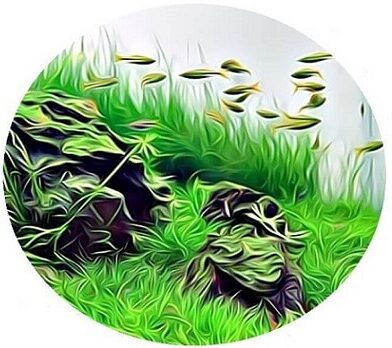Cycling your aquarium
The most essential step during an aquarium setup is the so called cycling your aquarium. This crucial step will avoid fish death, algae, and many other problems in the near future.
This article will address the common concern about the optimal time to introduce fish to a new tank, the effects of ammonia accumulation, a byproduct of organic material breakdown, and its potential harm to aquatic life.
We will also explore the nitrogen cycle, a biological process where beneficial bacteria play a pivotal role in converting ammonia to less harmful compounds, nitrite, and nitrate.
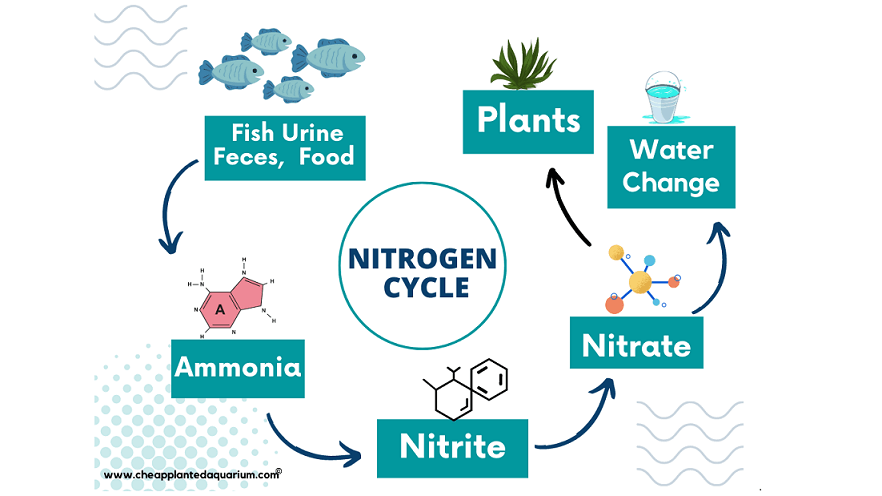
I will describe multiple methods for effectively cycling an aquarium, whether with fish, fish food, or over-the-counter bacteria.
This article is a valuable guide for aquarium enthusiasts seeking a thorough understanding of the nitrogen cycle and optimal tank preparation.
Table of Content
Why do Aquariums need to be Cycled?
Aquariums need to be cycled because this process will avoid fish death, algae, and many other problems as it will grow beneficial bacteria that will make the biological filtration of your water.
Organic material generated by dead fish decomposition, food scraps, or fish urine and feces becomes Ammonia. Ammonia accumulation in the aquarium’s water leads most fish to death, as it is a harmful substance that needs to be removed or neutralized. Even 0.25 ppm or 0.5 ppm of Ammonia are toxic.
Ammonia will always be generated, but fortunately, specific bacteria can consume it, keeping its level very low or almost zero. These bacteria will convert Ammonia into Nitrite, which is also harmful.
Still, luckily, another group of bacteria will convert Nitrite into Nitrate, which is much less toxic.
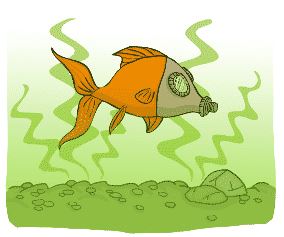
Having these two groups of beneficial bacteria in your aquarium is essential.
The biological process where bacteria convert Ammonia to Nitrite to Nitrate is called the “nitrogen cycle.”
Note 1: If you suspect that your fish are poisoned with ammonia, see the symptoms here.
Note 2: If you are here because your ammonia level is high, this article explains how to reduce it right away.
A very common question among fish lovers is how long do you have to wait to put fish in a new tank? Jump to the topic here.
Do you want to know how to cycle a planted aquarium? Jump directly to the point here.
What is the Aquarium Nitrogen Cycle
The aquarium nitrogen cycle is a process where colonies of beneficial bacteria consume Ammonia and Nitrite present in the aquarium water that is lethal to fish, snails, and invertebrates.
It is a biological process where Ammonia (NH3) is converted to Nitrite (NO2), and then the Nitrite is converted to Nitrate (NO3).
So, Ammonia becomes Nitrite which becomes Nitrate.
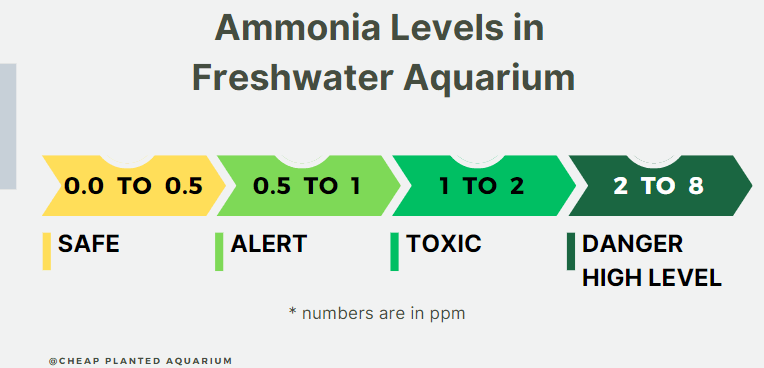
This process is essential for anyone setting up a new freshwater aquarium, and it is usually called “cycling the aquarium.”
The longer the cycling time, the larger the colony of good bacteria you will have.
If you don’t cycle your aquarium, i.e., don’t create enough beneficial bacteria, Ammonia levels will rise sooner or later and cause health problems or even fish death.
How is Ammonia processed in Nature?
Ammonia is processed in nature (in ponds, lakes, and rivers) through tons of aerobic bacteria that transform Ammonia into Nitrites. These bacteria (Nitrosomonas) feed on the energy released by the reaction (chemical reaction).
Nitrites are also quite harmful to fish. Fortunately, another group of also aerobic bacteria called Nitrobacter oxidizes nitrites into nitrates.
Again, these bacteria feed on the energy released by the reaction.
Finally, the nitrates formed by this process are less harmful than Ammonia or Nitrites. Plants and Algae consume Nitrates keeping their levels low.
How is Ammonia processed in an Aquarium?
Ammonia is processed in an aquarium through good bacteria. We need to grow these bacteria in our aquarium water so they will consume the Ammonia and Nitrite.
The time required for such bacteria colonies to establish themselves in our aquariums varies with several factors such as temperature, type of substrate, pH, and oxygen content of the water.
It can take about 10 to 15 days for the ammonia-consuming bacteria to establish themselves and start acting. When this happens, nitrite levels rise (Ammonia becomes Nitrite) and reach their maximum by the 15th day.
Now It’s time for the other colony of bacteria to start growing and turning the nitrites into nitrates.
Note that, under normal conditions, nitrates rise, exceeding the concentration of nitrites between 20 and 25 days.
By now, Ammonia and Nitrites should be under control.
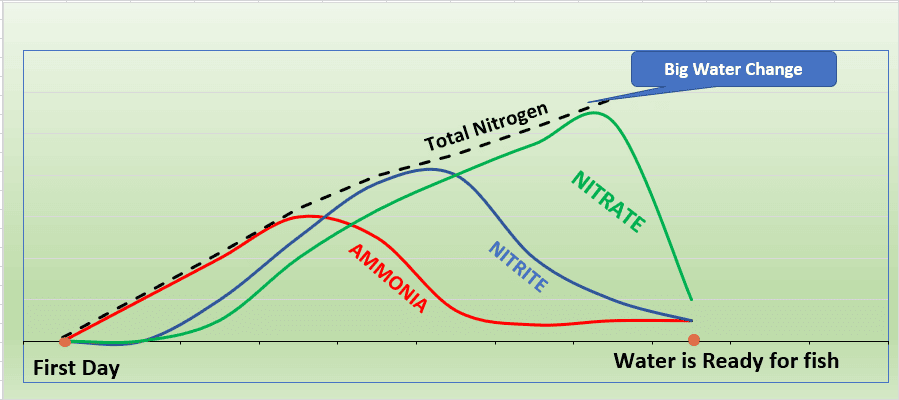
When the nitrites are finally close to zero, it is a sign that there are already enough bacteria to consume these substances (Ammonia and nitrites) in the aquarium.
Pay attention to the fact that, at this time, the concentration of nitrates will be high.
I recommend a partial water change to reduce Nitrate levels and prepare the water to receive its first inhabitants.
Plants will also help reduce Nitrate levels.
Note that the times used in this explanation are an approximate basis only. They can vary drastically depending on the factors mentioned and several others.
Aquarium Biological Filter media for Water Filter – What is this?
As explained earlier, Cycling your aquarium means growing bacteria to consume Ammonia and Nitrite so your water will be safe for your fish.
These bacteria will mostly grow in your water filter and substrate. In fact, they will be present throughout the aquarium (rocks, decorations, plants, etc.), but their greatest efficiency will occur inside your water filter, where the water will be flowing around them.
Having some “aquarium biological filter media” inside your filter is recommended for such bacteria to grow. These particular media are usually more porous than other materials. They are built in oval or cylindrical forms to facilitate the water flow through and around them.
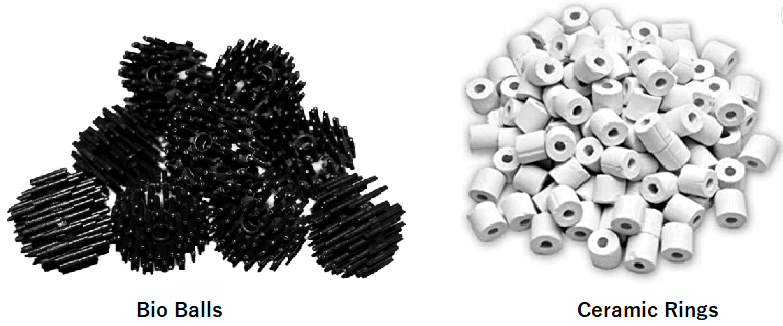
The biological filter media most used by aquarists within their filters are sponges, bio-balls, and ceramic rings.
The larger their surface, the larger their colonies will be.
Learn more about biological filtration here.
Cycling an Aquarium step by step
Table of Content
- Cycling an aquarium without fish but with fish food
- Fast Cycling an aquarium with no chemicals
- Cycling an aquarium faster with Live over-the-counter bacteria
- Cycling an aquarium With Fish method
- Cycling a Planted Tank
- How to know if the aquarium water is already cycled?
- How long you should wait to put new fish in tank?
Cycling an Aquarium Without Fish but with fish food
Let’s go through the steps:
- Buy an Ammonia and a Nitrite freshwater test kit. My recommendations are here.
- Finish assembling your aquarium, and place substrate, decorations, plants, and rocks.
- Fill it with water.
- Install and turn on your filtration system (if possible, put some bio-balls, ceramic rings, or other special media inside it).
- Adjust your water heater to 85 F (29oC) so those bacteria will grow faster.
- Measure your water ammonia and nitrites level and take note of it.
- Throw a teaspoon of fish food in your tank (for less than 10 gal tank, add half of it)
- Throw again after 3 days. Measure your water ammonia and nitrites level and take note of it.
- Throw again after another 3 days. Keep throwing this teaspoon or half of it every 3 days until your aquarium is cycled (explanation below).
- Keep Measuring the Ammonia and Nitrite levels every day or two.
- Whenever you see a detectable amount of Ammonia (anything above 0.2 ppm), you will know the process is starting.
>> Click here for the next step (how to know when the aquarium is cycled).
Fast Cycling an aquarium without chemicals
Let’s go through the steps:
- Buy an Ammonia and a Nitrite freshwater test kit. My recommendations are here.
- Finish assembling your aquarium, and place substrate, decorations, plants, and rocks.
- Fill it with water.
- Install and turn on your filtration system (if possible, put some bio-balls, ceramic rings, or other special media inside it).
- Adjust your water heater to 85 F (29oC) so those bacteria will grow faster.
- Measure your water ammonia and nitrites level and take note of it.
- Buy a raw cooked or uncooked, frozen shrimp at the grocery store, lay it in a fish net or a media bag or something similar and put it in your tank.
- Wait 4 days, keeping your water filter always on and the raw shrimp in the aquarium.
- Measure your water Ammonia and Nitrites level and take note of it.
- If you don’t see the Ammonia levels increasing, wait another two days.
- Measure your water Ammonia and Nitrites level and take note of it.
- Keep measuring and waiting until you see an increase in your ammonia level. Whenever you see a detectable amount of Ammonia (anything above 0.2 ppm), you will know the process is starting.
Note: keep the shrimp until the cycle is completed.
>> Click here for the next step (how to know when the aquarium is cycled).
Cycling an aquarium faster with Live over-the-counter bacteria
Let’s go through the steps:
- Finish assembling your aquarium, and place substrate, decorations, plants, and rocks.
- Fill it with water.
- Install and turn on your filtration system (if possible, put some bio-balls, ceramic rings, or other special media inside it).
- Use Seachem Stability following the manufacturer’s directions. Seachem says you can put your fish in the aquarium after 7 days. I recommend you start with 1 to 3 fish for some days only to ensure everything is fine and to avoid generating a lot of Ammonia at once.
>> Click here for the next step (how to know when the aquarium is cycled).
Cycling an aquarium With Fish method
In this method, you will insert one or two very resistant fish into your tank and lightly feed them for some days.
You would gradually increase the food quantity so their waste would produce Ammonia and start the nitrogen cycle and bacteria creation.
I don’t like and recommend this method because, in the end, you will end up having a fish you may not want to have, and I wonder how safe this method is for this fish.
Aquarium Coop has a very good step-by-step here if you are interested in this method.
>> Click here for the next step (how to know when the aquarium is cycled).
Cycling a planted tank
Planted Tanks are aquariums with a considerable amount of aquatic plants (click here to learn more about planted tanks).
Even being a planted tank, you will, sooner or later, add fish, snails, or shrimp, and then, you will need to cycle your aquarium.
Cycling a planted aquarium is exactly the same as a standard aquarium, but the time necessary to complete the cycling will be shorter as plants will help with the cycling and bacteria creation.
As described before, there are at least 4 ways to cycle your aquarium. Choose one that fits better to your needs, I have listed them here.
How to know if the aquarium water is already cycled?
How long you should wait to put new fish in tank?
As described before, you should keep measuring the ammonia and nitrites levels every 2 day at this point.
Ammonia levels will peak and drop to close to zero.
Nitrite levels too. It will peak and drop to close to zero.
Keep Testing your water and see if the Ammonia and Nitrite will go up and down again. In this way, you will see the process happening. When your Ammonia and nitrites are near zero again, you will be sure it is ready for fish.

Adjust your water heater to the desired temperature.
Remove the raw shrimp.
Do a 50% partial water change with good water (no chlorine, etc.) to reduce Nitrate levels and prepare the water to receive its first inhabitants.
At this point, do a final Measurement of your water ammonia and nitrites level to ensure everything is correct.
Check pH, water temperature, and other water parameters. I have a comprehensive article explaining water hardens, ph, chlorine, etc. it is ?here?
Your tank should be ready to receive fish.
Keep measuring your ammonia and nitrite levels every 2 days for the first 2 weeks.
After that, you can monitor their level weekly.
Products recommendation
Here are the products I have been using since years.
How to test Ammonia in fish tank?
To test Ammonia levels in a fish tank, you can use this Ammonia Test Kit. This is the one I use and recommend.
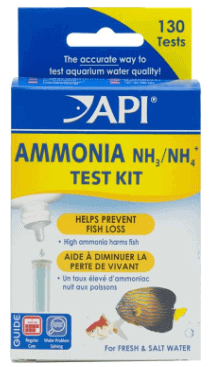
How to test Nitrite in fish tank?
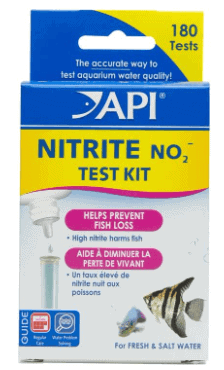
Ammonia neutralizer
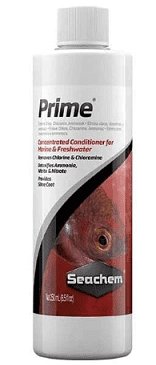
Nitrogen Cycle Kick Start – Seachem Stability
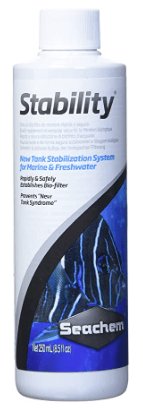
How to lower Ammonia level in an aquarium
Bad things happen; sometimes, you could have an Ammonia spike and need to reduce its levels.
In situations like that, you can use aquarium-specific products that convert your Ammonia into something safe for your fish.
I recommend you Seachem Prime.

Check this article where I explain what needs to be done to lower your ammonia right away.
If I leave the aquarium running for 30 days without fauna, will it be cycling?
Most probably, yes. It might need more time, but it will get cycled for sure. Test your water after 5 days, after 10 days, 15 days, 20, and 30 days and see if the Ammonia and Nitrites will go up and down again.
Have a look at this article to learn about other water parameters.
Ammonia and nitrites levels must be close to zero before you add fish to the aquarium.
Do I need to cycle a planted shrimp tank?
For sure! Shrimps are very sensitive to ammonia. They are more sensitive than fish! Fish can tolerate some minimum level of ammonia but shrimps can’t.
There are at least 4 ways to cycle your planted tank with shrimps aquarium. Choose one that fits better to your needs, I have listed them here.
References
The Florida Department of Agriculture and Consumer Services have a great article about “Aquarium Water Quality: Nitrogen Cycle” that I really recommend you to have a look. It is here.
If you want to go deeper and read more about those anaerobic ammonia-oxidizing (anammox) bacteria, check the article “Biogeography of anaerobic ammonia-oxidizing (anammox) bacteria” from the Department of Biology, University of Waterloo, Waterloo, ON, Canada, here.
I also used information from the “A Brief History of Prime” from “dasaltemelosguy” in the Forum Aquarium Co-Op. You can find it here.
The aquascape.blog has a good article here where you can learn more.
Another great source of information is the AquariumScience.org from David Bogert, here
